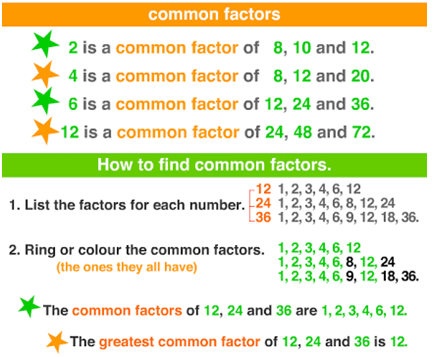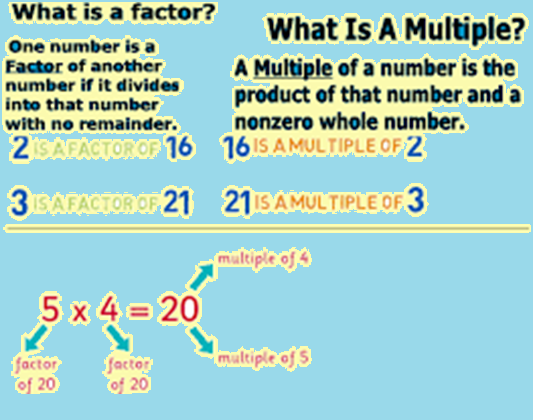CLASS-6
FACTORS & MULTIPLES
FACTORS & MULTIPLES -
Factors and multiples are fundamental concepts in mathematics that relate to the relationships between numbers. Let's explore both terms:
Factors:-
A factor of a number is an integer that divides the number without leaving a remainder. In other words, if you can multiply a factor by another integer to get the original number, then the first integer is a factor of the second. For example, the factors of 12 are 1, 2, 3, 4, 6, and 12, because these numbers can all divide 12 evenly. A factor of a number is an integer that divides the given number without leaving a remainder. In other words, if you can multiply the factor by another integer to get the original number, then that integer is a factor of the original number.For example, the factors of 12 are 1, 2, 3, 4, 6, and 12. This is because:-
1 * 12 = 12,
2 * 6 = 12,
3 * 4 = 12,

Multiples: -
A multiple of a number is the result of multiplying that number by an integer. For example, the multiples of 3 are 3, 6, 9, 12, 15, and so on, since each of these numbers can be obtained by multiplying 3 by different integers. A multiple of a number is the result of multiplying that number by an integer. In simple terms, multiples are numbers that can be obtained by repeatedly adding the given number to itself.For example, the multiples of 5 are 5, 10, 15, 20, 25, and so on. This is because:-
5 * 1 = 5
5 * 2 = 10
5 * 3 = 15
5 * 4 = 20
5 * 5 = 25
Relationship between Factors and Multiples:-
- Every number is a multiple of itself, and it has at least two factors: 1 and itself.
- If a number has more than two factors, it's called a composite number. If it has exactly two factors (1 and itself), it's called a prime number.
- The concept of factors is closely related to divisibility. If a number "A" is a factor of another number "B," then "B" is divisible by "A."
- Common factors are factors that two or more numbers share. For example, the common factors of 12 and 18 are 1, 2, 3, and 6.
- The least common multiple (LCM) of two or more numbers is the smallest multiple that they have in common. For example, the LCM of 3 and 4 is 12, because it's the smallest number that is divisible by both 3 and 4.
- Factors and multiples are related in the sense that the factors of a number are exactly those numbers for which the given number is a multiple.
- For example, using the previous example, the factors of 12 are 1, 2, 3, 4, 6, and 12. These are the same numbers that, when multiplied by another number, result in a multiple of 12.

It's important to note that:-
- Every number is a factor of itself, and every number is a multiple of itself.
- The smallest positive factor of any positive integer (except 1) is 1, and the largest factor (except itself) is the number itself.
Factors and multiples play a crucial role in various mathematical operations and concepts, such as prime numbers, greatest common divisors (GCD), least common multiples (LCM), and simplifying fractions, among others.
Let's take the numbers 6 and 9:-
- The factors of 6 are 1, 2, 3, and 6.
- The factors of 9 are 1, 3, and 9.
- The common factors of 6 and 9 are 1 and 3.
- The least common multiple (LCM) of 6 and 9 is 18, because it's the smallest multiple that they both share.
Understanding factors and multiples is crucial for various mathematical operations, including simplifying fractions, finding common denominators, and solving equations involving integers.